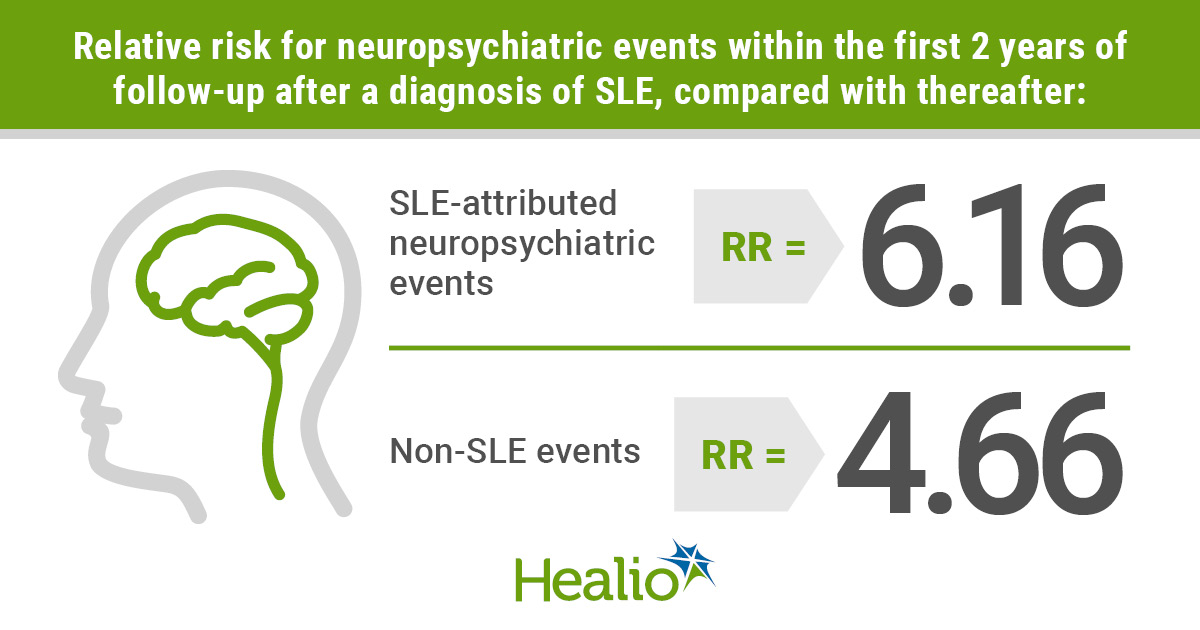Neuropsychiatric Events Most Frequent Near SLE Diagnosis, Linked to Excess Mortality
Among patients with systemic lupus erythematosus, neuropsychiatric events occur most frequently around the time of the initial diagnosis, and are associated with reduced health-related quality of life and excess mortality, according to data published in the Annals of the Rheumatic Diseases.
“Approximately 30% of [neuropsychiatric (NP)] events are attributed to SLE, although the rate varies between individual manifestations,” John G. Hanly, MD, of the Queen Elizabeth II Health Sciences Centre and Dalhousie University, in Halifax, Canada, and colleagues wrote. “Regardless of attribution, the majority of events are associated with lower self-reported health-related quality of life (HRQoL).”
“There are few clinical trials to guide interventions in SLE patients with NP events,” they added. “Many observational studies are single center experiences, frequently cross-sectional in design and use prevalent SLE cohorts. Longitudinal studies have not captured the bidirectional movement of patients between remissions and relapses of NP events, the duration in different NP states and likelihood of moving from one state to another over time.”
To analyze the causes and outcomes of neuropsychiatric events, and their impact on quality of life, among a large, international cohort of patients with SLE, Hanly and colleagues worked through the Systemic Lupus International Collaborating Clinics (SLICC). According to the researchers, SLICC is a network of 52 investigators at 43 academic centers in 16 countries. A total of 1,827 patients were recruited, up to 15 months following their SLE diagnosis, from 31 SLICC centers in Europe, Asia and North America.

The researchers identified neuropsychiatric events using American College of Rheumatology case definitions for 19 neuropsychiatric syndromes. Participants were assessed within the enrollment window — 6 months prior to their SLE diagnosis, through the enrollment date — and reassessed each year within a 6-month window. The researchers also measured outcomes and participants health related quality of life, using short-form 36 (SF-36) scores. In addition, they used time-to-event analysis and multistate modelling to evaluate the onset, recurrence and transition between neuropsychiatric states.
According to the researchers, neuropsychiatric events occurred in 52.3% of participants patients, 31% of unique events attributed to SLE. In the first 2years of follow-up, the relative risk was 6.16 (95% CI, 4.96-7.66) for SLE-attributed neuropsychiatric events and 4.66 (95% CI, 4.01-5.43) for non-SLE events, compared with after the first 2 years. In addition, participants without SLE-related events at their initial assessment demonstrated a 74% likelihood of being event free at 10 years. For non-SLE events, the estimate was 48%.
Although the majority of neuropsychiatric events resolved within 10 years, the mortality rate among participants with events attributed to SLE was 16%, compared with 6% for those with no SLE-related events, 7% in those with non-SLE events, and 6% in patients with no non-SLE events. Patients with neuropsychiatric events also had lower SF-36 summary scores, compared with those without events and resolved neuropsychiatric states (P < .001).
“Although NP events can present or recur at any time in the disease course, they are most frequent in the first few years following SLE diagnosis,” Hanly and colleagues wrote. “This is the case for both NP events attributed to SLE and non-SLE causes, although the rate of recurrence compared with the rate for the initial event is higher for NP events attributed to SLE. As is the case with other SLE manifestations, the occurrence of NP manifestations has implications for the subsequent disease course.” – by Jason Laday
Disclosure: Hanly reports no relevant financial disclosures. Please see the study for all other authors’ relevant financial disclosures.
